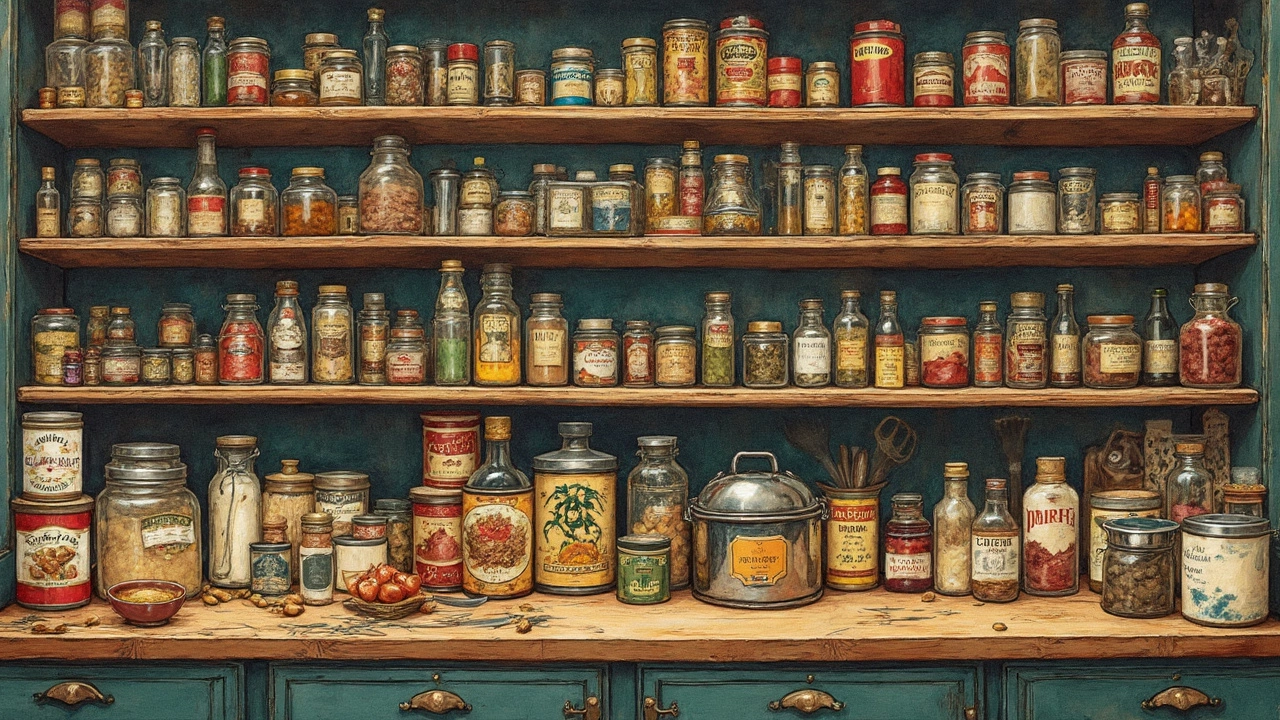Ever thought you were on top of your gluten-free game only to get blindsided by a seemingly innocent product? It turns out, gluten is a master of disguise, sneaking into foods where you’d least expect it. You'd be surprised at some of the everyday items packing a gluten punch.
Let's talk processed foods first. You'd think the gluten culprits are just bread and pasta, right? Wrong. Did you know some brands of potato chips and even deli meats contain gluten? Yeah, mind-boggling. Gluten pops up in the most unsuspecting items through additives like malt flavoring or modified food starch, common binders and thickeners in processed goods.
And it doesn't stop there. Sauces, man, are another sneaky source. Your favorite soy sauce, for instance, unless specified gluten-free, is likely brewed using wheat. Even salad dressings or marinades might harbor gluten under labels that don't scream 'wheat.' Use caution and maybe a magnifying glass.
- Unexpected Processed Foods
- Sneaky Sauces and Dressings
- Surprising Snacks
- Unexpected Drinks
- Common Condiments
- Gluten in Meat Substitutes
Unexpected Processed Foods
So you're dodging gluten like a pro, steering clear of anything that looks remotely like bread. But bam! Gluten's lurking in some processed foods that seem totally safe. Let's shine a light on these sneaky culprits.
Many people don't realize that gluten can be hiding in processed meats. Yep, that seemingly harmless turkey slice from your deli counter could be loaded with gluten. Often, these meats use fillers or binders, such as modified food starch or even maltodextrin, which could be derived from wheat. Always check the labels.
Another shocker? Frozen french fries. While potatoes are naturally gluten-free, some brands coat their fries with a thin layer of flour to make them crispier. It's a sneaky trick you wouldn't expect. The same goes for some hash browns.
Then there are those boxed rice mixes and flavored instant noodles. You’d think rice and noodles scream gluten-free, right? But those seasoning packets often contain gluten-based thickeners or even soy sauce powder made from wheat.
| Food Type | Possible Sources of Gluten |
|---|---|
| Processed Meats | Fillers, binders |
| Frozen Fries | Flour coating |
| Flavored Rice & Pasta | Seasoning packets |
When shopping, your best defense is that nutrition label. Gluten ingredients like wheat starch, barley malt, or rye can lurk in plain sight. Opt for products explicitly labeled gluten-free whenever possible. Making a habit of reading and understanding these details can save you from unexpected gluten encounters and keep your diet on track.
Sneaky Sauces and Dressings
So you're thinking of making a stir-fry or a nice salad, and here comes the tricky part—sauces and dressings. It’s easy to think they’re just harmless flavor enhancers, but these bad boys can easily sneak gluten into your meal.
Take soy sauce, for one. Most traditional soy sauces are brewed with wheat. So unless it clearly says 'gluten-free,' it's probably not safe for someone avoiding gluten. Who knew, right?
“Gluten can often hide in sauces, dressings, and marinades under labels like 'malt' or 'food starch,'” says Dr. Alice Miller, a dietitian specializing in gluten-free living.
Think salad dressings are safe? Not necessarily! Many contain malt vinegar or wheat as a thickener. Your seemingly healthy salad might be packing more than just calories. Always double-check those ingredients.
Here’s another tip: marinades and gravies. Pre-made ones often use things like flour or starches, which can contain gluten. Opt for making your own or choose ‘gluten-free’ marked versions.
- Read the label before buying any sauce or dressing.
- Look for terms like 'malt' or 'modified food starch,' which usually indicate gluten.
- Prefer naturally gluten-free alternatives like tamari instead of regular soy sauce.
Being smart about your sauces can go a long way in maintaining a healthy gluten-free diet. A little awareness can prevent gluten from sneaking into your meals sneakily.
Surprising Snacks
Alright, so you're munching away happily on your favorite snacks, thinking you're safe from gluten, and then—bam! Even snacks can be tricksters when it comes to gluten content. It's not just about bread or cookies anymore. Let's unwrap this surprise together.
Take crispy snacks like flavored popcorn or potato chips, for starters. If you're not careful, these guys might sprinkle some gluten magic into their seasoning. Flavored chips could be dusted with seasonings containing wheat or barley malt—which means gluten might be lurking in that tasty crunch.
How about those chocolate bars you've been nibbling on while binging shows? Some chocolates use barley malt, which finds its way in as a flavoring agent. Always check those labels or stick to brands known to be gluten-free.
Imagine this: you're at a party and those mini pretzels or cheese balls seem harmless. Well, guess what? Traditional pretzels are made with wheat flour, and cheeses sometimes have additives that aren't gluten-free.
- Read every label. Seriously, become an ingredient detective.
- Stick to brands that clearly label their products as gluten-free. Trustworthy labeling makes life easier.
- Better yet, go for naturally gluten-free snacks like fruits, nuts, or gluten-free labeled popcorn for a safe bet.
Being aware is key here. Keep your eyes peeled for unexpected gluten in these and other tasty treats, so your snack time stays enjoyable, not gut-wrenching.

Unexpected Drinks
Alright, let’s spill the tea—or in this case, something with a little gluten lurking inside. If you’re thinking you’re safe while sipping on anything liquid, think again. There are drinks that might just disrupt your gluten-free lifestyle without you even realizing it.
First stop, beer. It’s the most obvious offender in the alcohol department because it’s typically made from barley or wheat. But here’s the kicker: even some gluten-free labeled beers might contain traces of gluten. So, if you're super sensitive, you might want to stick to certified brands or shift to a gluten-free cider instead.
Ever heard of malt beverages? They’re another sneaky source to be wary of. Think flavored hard seltzers and some premixed cocktails. The 'malt' in there translates to gluten, in ways you won't find written in bold on the label.
And here’s a surprise—watch out for certain vodkas and whiskies too. While distillation should remove gluten proteins, cross-contamination during production or aging (especially with whiskey) can happen. It’s safer to verify with the brands if they’re truly gluten-free from start to finish.
Lastly, non-alcoholic beverages can catch you off guard as well. Some root beers, ciders, and even flavored coffee creamers may have barley-derived ingredients. Reading labels extensively and researching before you indulge is key.
| Drink Type | Potential Gluten Source |
|---|---|
| Beer | Barley/Wheat |
| Malt Beverages | Malt (Barley) |
| Whiskey | Barley (Potential Cross-Contamination) |
| Root Beer & Ciders | Barley |
So here’s the deal: always bring your investigative skills to the store. The gluten-free label isn’t a guarantee. Double-check the ingredients and reach out to manufacturers when in doubt. Your digestive system will thank you for it.
Common Condiments
Condiments are the unsung heroes of flavor, adding that extra zing and zest to our meals. But when you're on a gluten-free journey, they're not as innocent as they seem. Some of these tasty companions sneak gluten into your diet when you're not looking!
Let's start with ketchup. Most big brands might be okay, but check the label. Certain varieties use malt vinegar derived from barley or unknown thickeners that contain gluten. It's always a good bet to choose those marked specifically as gluten-free.
Mustard, a fan favorite for sandwiches and dressings, is another condiment that can be suspect. Some brands add wheat flour or beer for a distinctive flavor, which is a no-go for anyone avoiding gluten. Again, your safest bet is to go for confirmed gluten-free brands.
Barbecue sauce, oh, the love-hate relationship! Some contain soy sauce or malt vinegar as part of their secret ingredient list. Always aim to check that ingredient label if you want to keep your ribs safe.
Ever considered salad dressing? While a drizzle of tangy dressing makes your greens pop, it's worth noting many contain thickening agents with gluten. Breadcrumbs in Caesar dressings are also a sneaky addition you don’t want to miss.
Below is a quick glance at which condiments to watch:
- Ketchup: Stick to gluten-free labels.
- Mustard: Check for hidden wheat or beer.
- Barbecue sauce: Verify for soy sauce or malt vinegar.
- Salad dressings: Be wary of thickeners and breadcrumbs.
Keeping an eye out for hidden gluten lets you enjoy your meals without fearing unexpected surprises. It's all about knowing what's in the bottle before you pour.
Gluten in Meat Substitutes
Going meatless doesn’t always mean going gluten-free. Enter the world of meat substitutes, where gluten frequently hides in plain sight. Many folks switch to plant-based diets for different reasons—health, environment—you name it. But if you're also dodging gluten, there are some landmines.
Take seitan, for instance. Ever heard of it? It’s often dubbed ‘wheat meat’ because, surprise—it’s made from gluten. Despite its plant-based legs, seitan is a big no-no for anyone avoiding gluten.
Then you’ve got vegetable burgers and soy-based products. They might seem like a safe haven, but read those labels carefully. Some brands use wheat-based fillers or breading, making these products a gluten trap. Always look for specific ‘gluten-free’ markings when picking such items.
Here’s a fun fact that’ll make you the smartest gluten-free person in the room: some meat substitutes sneak gluten in through ingredients like barley malt, which lends a certain flavor but can trip up unsuspecting buyers.
To avoid the gluten pitfalls of meat substitutes, always check labels for ingredient lists mentioning gluten-heavy items like wheat, barley, or rye. Don’t let that veggie burger fool you with its green branding; the proof is always in the pudding—or, in this case, the ingredients list.
Staying vigilant isn't just for the grocery store aisles; even eating out requires sharp gluten-detection skills. If you're dining at a vegan spot, never shy away from asking specific questions about gluten content. Trust me, chefs and servers have heard it all before!
Remember to keep an eye out not only for the obvious gluten sources but also for those pesky hidden ones. Going gluten-free might seem like a daunting task, but a little knowledge goes a long way in making informed choices.

